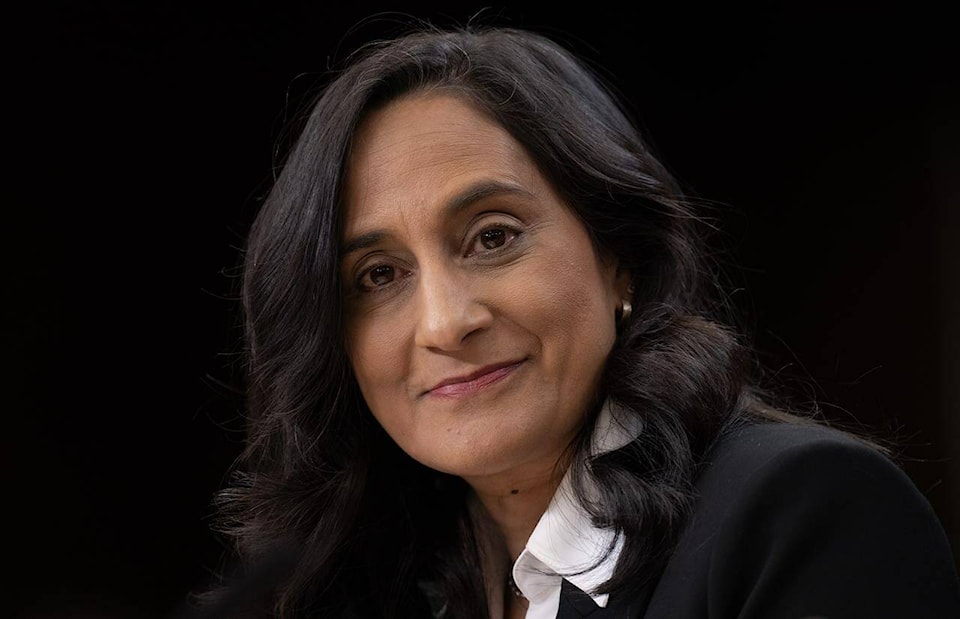Corporate boardrooms. Military barracks. Federal government offices.
They’re not locales with a reputation for fostering diversity.
Anita Anand has been trying to change that.
Ensuring people of all backgrounds feel accepted and heard no matter the venue is a mission that has followed her at every stage in her life and career, she said in a recent interview.
“This is a very personal issue for me,” said Anand, who is the first person of colour to hold the federal government’s purse strings as Treasury Board president.
“I still walk into rooms and look at tables that are not diverse.”
Case in point: in February, Anand walked into a briefing regarding mental-health counselling for Black public-service workers.
There were no Black employees in the room, she said.
“I said to the individuals briefing me: ‘Why aren’t there any Black individuals facing me?’ This is not acceptable.”
Part of her mandate is to dismantle systemic barriers in the federal public service that allow workplace harassment, bullying, racism and other forms of discrimination and violence to fester.
It needs to happen at all levels, she said.
“We actually want to ensure we see diversity in briefing rooms for the minister, at the deputy minister level, at the assistant deputy minister level.”
Anand is no stranger to what racial discrimination can feel like.
Before she became the member of Parliament for Oakville, Ont., in 2019, she worked as a lawyer and law professor.
At one workplace, she said, people would often ask if she was in the accounting department.
“That struck me because there were more South Asians in the accounting department than there were in the school of lawyers,” she said.
“Often I would get confused with other Indian women that were working in the same work environment that I was.”
Rather than focusing on such events, she said she has put far more energy toward understanding how to improve the situation.
That included working at the United Nations, writing a thesis on racial discrimination in Canada, and researching the number of racialized individuals on boards of directors when she was a professor.
“At every stage of my life, I have tried to incorporate my views about diversity and inclusivity in everything I am doing,” Anand said.
“It’s not that I have to try to do it. It is a natural part of the way I think.”
Anand said it’s difficult to pick out a point in time when she became aware of her own racial identity.
“I’ll just say that was very stark for me growing up.”
Her Indian parents met in Ireland in the 1950s as physicians, got married in England, then lived in India and Nigeria before immigrating to Canada.
“They raised their three daughters in a predominantly white province with very few South Asians when they moved,” she said.
“We had a wonderful upbringing in Kentville, Nova Scotia, but the fact that I was racialized never left my consciousness. There weren’t very many people who looked like me and my sisters at my school.”
Part of her goal now is to make sure racialized children can see themselves in all manner of jobs, including in high-ranking government and military roles.
As defence minister, Anand said she told her team that cultural change was a file that “should not leave the centre of my desk.”
In the months before she took the file in fall 2021, a string of senior military leaders were accused of sexual misconduct.
And just over half a year into her tenure, Supreme Court Justice Louise Arbour released the results of an external review, saying the culture within the Canadian Armed Forces was “deeply deficient.”
Anand accepted Arbour’s recommendations for change, admitting in a statement upon its anniversary in May 2023 that “change does not happen overnight, and it will not continue without effort.”
She was assigned to oversee the public service last July.
About 80,000 people are in the Canadian Forces, Anand said, but the number is closer to 275,000 for the entire public service.
The problems of that larger group seem to have flown under the radar, Anand said.
“Maybe it’s the (sexual misconduct) cases, maybe that it’s more stark because of the hierarchy that is so evident in uniforms and badges in the Canadian Armed Forces, compared to the public service, where we’re not wearing uniforms,” she said.
“But the issues are palpable.”
A panel of experts the Treasury Board tapped to help with workplace culture has recommended major changes, including instituting mandatory racism, discrimination and harassment training.
The panel also said employees must have mental-health counselling supports, and managers need to be trained in trauma-informed leadership.
As she reviews the recommendations, Anand said she will develop a path forward, with an action plan ready to go before the summer.
It won’t leave the centre of her desk, she said.
“This is not something that I have to worry about whether I will remember,” Anand said.
“It is as a function of who I am.”
READ ALSO:
Mickey Djuric, The Canadian Press



